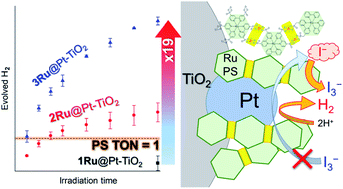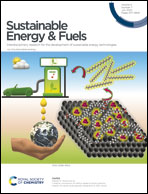Photosensitizing ruthenium(ii)–dye multilayers: photoinduced charge separation and back electron transfer suppression†
Abstract
Photocatalytic H2 evolution activity of three types of Ru(II)-photosensitizer(PS)-multilayered Pt-cocatalyst loaded TiO2 nanoparticles, RuCP2@Pt–TiO2, RuCP2–Zr–RuP6@Pt–TiO2, and RuCP2–Zr–RuP4–Zr–RuP6@Pt–TiO2 were investigated in the presence of the redox-reversible iodide electron donor aqueous solution. The apparent quantum yield (AQY) significantly improved by about 40 times by increasing the number of Ru(II)–PS layers and decreasing the loading amount of Pt cocatalyst on the surface of TiO2 nanoparticles. The zeta potential measurement suggests that the Zr4+ cations between the PS-layers acted as the iodide capturing sites to promote the electron donation. Photocurrent–voltage characteristics of the Ru(II)–PS-multilayered photoelectrodes RuCP2@TiO2–ITO, RuCP2–Zr–RuP6@TiO2–ITO, and RuCP2–Zr–RuP4–Zr–RuP6@TiO2–ITO in aqueous I−/I3− electrolyte solution revealed that the thicker Ru(II)–PS-layer with the Zr4+ cations contributes not only to suppressing the back electron transfer from Pt–TiO2 surface to the oxidized iodine species but also to enhancing the photoinduced electron injection.

- This article is part of the themed collection: Artificial Photosynthesis - From Sunlight to Fuels and Valuable Products for a Sustainable Future


 Please wait while we load your content...
Please wait while we load your content...